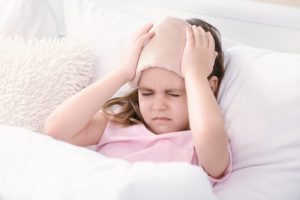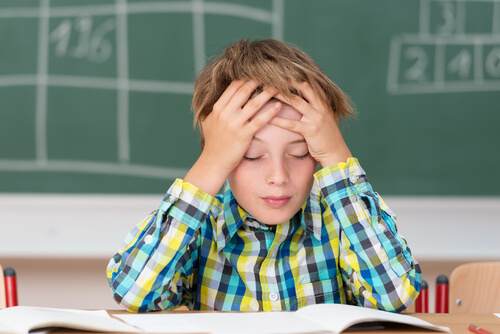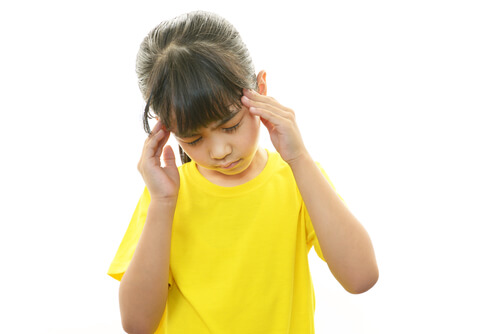Infant Migraines: Symptoms, Causes and Treatment

What are infant migraines?
In most cases, infant migraines consist of a very intense headache. It is a neurological disorder that occurs outside of the cranium.
It occurs because of swelling in the muscles that cover the head and neck that affect the surrounding nerves. This sends pain messages to the brain that cause the migraine.
Causes of migraines in children
There are several situations that cause children to suffer frequent headaches, although sometimes they are mild.
However, sometimes the pain is very strong and can last several hours or even days. Some of the most common causes are the following:
- Excessive use of computers, video games or television.
- Fatigue, tiredness and stress.
- Hormonal changes.
- Sensitivity to strong smells or noises.
- Periods of anxiety.
- Vision problems.
- Flu or infections in the ear, throat, or urinary tract.
- Frequent tobacco inhalation.
- Lack of sleep.
- Side effects caused by certain medication.
- Poor nutrition.
“Some children with infant migraine manifest strong pain that can last hours or even days”
Main symptoms of infant migraines
Recognizing the symptoms will help you to adequately treat your child’s migraine. It will also help you determine whether you should seek medical attention, or care for your child at home.
This way, your child will feel better as soon as possible, meaning less suffering for your little one.
- Intermittent or palpitating pain in the head.
- Moderate or intense pain on one or both sides of the head.
- Nausea, vomiting or dizziness.
- Difficulty carrying out daily activities.
- The pain intensifies with physical activity.
- Sensitivity to sound and light.

How to help your child during a migraine crisis
The first treatment consists of giving your child a pain killer recommended by your pediatrician. The most common recommendations are ibuprofen or acetaminophen.
Keep your child in bed or lying down on a couch in a dark, silent room. Place a cold, wet towel on your child’s head, as this will be refreshing.
Massage your child’s scalp and press lightly on his temples. Try to help him fall asleep, as this will help him relax and relieve muscle tension. If your child is relaxed, this will help him reduce the pain or even make it disappear altogether.
Practical suggestions to avoid infant migraine
It’s important that you modify any of your little one’s habits that may be triggers for frequent headaches. Some of these habits might include:
- Control the amount of time that your child spends watching TV, playing video games or sitting at the computer.
- Avoid situations that cause stress, fatigue or tiredness.
- Provide a healthy diet. Good nutrition will help to strengthen your child’s immune system and thus resist frequent infection.
- Pay attention to see if certain foods like aged cheeses or chocolates trigger headaches. If they do, your child should not consume them.
- If your child is old enough, make sure he exercises and play sports regularly. This will help to improve his overall health.
- If your child takes medication, talk with your pediatrician about possible side effects.
- Have your child evaluated by a specialist to discard possible problems with his vision.
- Make sure your child gets enough sleep. Getting enough rest is restorative and therefore reduces the occurrence of infant migraine.

Nutrition plays an important role in children with migraines
In many cases, specialists have determined that poor nutrition provokes headaches in children. In the same way, infant migraine can be brought on by food allergies.
It’s vital, therefore, to pay attention to see if headaches occur after your child consumes certain foods. Avoiding lactose, canned goods, sweets, industrialized baked goods, overripe bananas, chocolates and aged cheeses is recommended.
“It’s important that you modify any of your little one’s habits that may be triggers for frequent headaches”
At the same time, you should include plenty of fruits, vegetables and whole wheat bread in your child’s diet. Also, choose foods that are rich in magnesium to help keep your little one healthy.
If your child suffers from infant migraine, don’t overworry. Tending to your child adequately is sufficient. Generally, infant migraine diminishes with the arrival of puberty.
What are infant migraines?
In most cases, infant migraines consist of a very intense headache. It is a neurological disorder that occurs outside of the cranium.
It occurs because of swelling in the muscles that cover the head and neck that affect the surrounding nerves. This sends pain messages to the brain that cause the migraine.
Causes of migraines in children
There are several situations that cause children to suffer frequent headaches, although sometimes they are mild.
However, sometimes the pain is very strong and can last several hours or even days. Some of the most common causes are the following:
- Excessive use of computers, video games or television.
- Fatigue, tiredness and stress.
- Hormonal changes.
- Sensitivity to strong smells or noises.
- Periods of anxiety.
- Vision problems.
- Flu or infections in the ear, throat, or urinary tract.
- Frequent tobacco inhalation.
- Lack of sleep.
- Side effects caused by certain medication.
- Poor nutrition.
“Some children with infant migraine manifest strong pain that can last hours or even days”
Main symptoms of infant migraines
Recognizing the symptoms will help you to adequately treat your child’s migraine. It will also help you determine whether you should seek medical attention, or care for your child at home.
This way, your child will feel better as soon as possible, meaning less suffering for your little one.
- Intermittent or palpitating pain in the head.
- Moderate or intense pain on one or both sides of the head.
- Nausea, vomiting or dizziness.
- Difficulty carrying out daily activities.
- The pain intensifies with physical activity.
- Sensitivity to sound and light.

How to help your child during a migraine crisis
The first treatment consists of giving your child a pain killer recommended by your pediatrician. The most common recommendations are ibuprofen or acetaminophen.
Keep your child in bed or lying down on a couch in a dark, silent room. Place a cold, wet towel on your child’s head, as this will be refreshing.
Massage your child’s scalp and press lightly on his temples. Try to help him fall asleep, as this will help him relax and relieve muscle tension. If your child is relaxed, this will help him reduce the pain or even make it disappear altogether.
Practical suggestions to avoid infant migraine
It’s important that you modify any of your little one’s habits that may be triggers for frequent headaches. Some of these habits might include:
- Control the amount of time that your child spends watching TV, playing video games or sitting at the computer.
- Avoid situations that cause stress, fatigue or tiredness.
- Provide a healthy diet. Good nutrition will help to strengthen your child’s immune system and thus resist frequent infection.
- Pay attention to see if certain foods like aged cheeses or chocolates trigger headaches. If they do, your child should not consume them.
- If your child is old enough, make sure he exercises and play sports regularly. This will help to improve his overall health.
- If your child takes medication, talk with your pediatrician about possible side effects.
- Have your child evaluated by a specialist to discard possible problems with his vision.
- Make sure your child gets enough sleep. Getting enough rest is restorative and therefore reduces the occurrence of infant migraine.

Nutrition plays an important role in children with migraines
In many cases, specialists have determined that poor nutrition provokes headaches in children. In the same way, infant migraine can be brought on by food allergies.
It’s vital, therefore, to pay attention to see if headaches occur after your child consumes certain foods. Avoiding lactose, canned goods, sweets, industrialized baked goods, overripe bananas, chocolates and aged cheeses is recommended.
“It’s important that you modify any of your little one’s habits that may be triggers for frequent headaches”
At the same time, you should include plenty of fruits, vegetables and whole wheat bread in your child’s diet. Also, choose foods that are rich in magnesium to help keep your little one healthy.
If your child suffers from infant migraine, don’t overworry. Tending to your child adequately is sufficient. Generally, infant migraine diminishes with the arrival of puberty.
All cited sources were thoroughly reviewed by our team to ensure their quality, reliability, currency, and validity. The bibliography of this article was considered reliable and of academic or scientific accuracy.
- Arroyo, H. A. (2007). Migraña y otras cefaleas primarias en la infancia y la adolescencia. Medicina (B Aires), 67, 623-30. http://medicinabuenosaires.com/revistas/vol67-07/n6-1/v67_6-1_p623_630_.pdf
- Bille B. (1991). Migraine in childhood and its prognosis. Cephalalgia. 1: 71-5.
- Cárdenas Guiraudy, A., García Martínez, D. A., Pozo Lauzan, D., Pozo Alonso, A., & Moroño Guerrero, M. (2005). Migraña: Estudio clínico-genético en niños y adolescentes. Revista Cubana de Pediatría, 77(1), 0-0. http://scielo.sld.cu/scielo.php?pid=S0034-75312005000100001&script=sci_arttext&tlng=en
- Mercado, E. B., & Bernal, J. I. C. (2010). Migraña infantil: prevalencia y características clínicas. Archivos de Investigación Materno Infantil, 2(3), 141-144. http://www.medigraphic.com/cgi-bin/new/resumen.cgi?IDARTICULO=27417
This text is provided for informational purposes only and does not replace consultation with a professional. If in doubt, consult your specialist.








